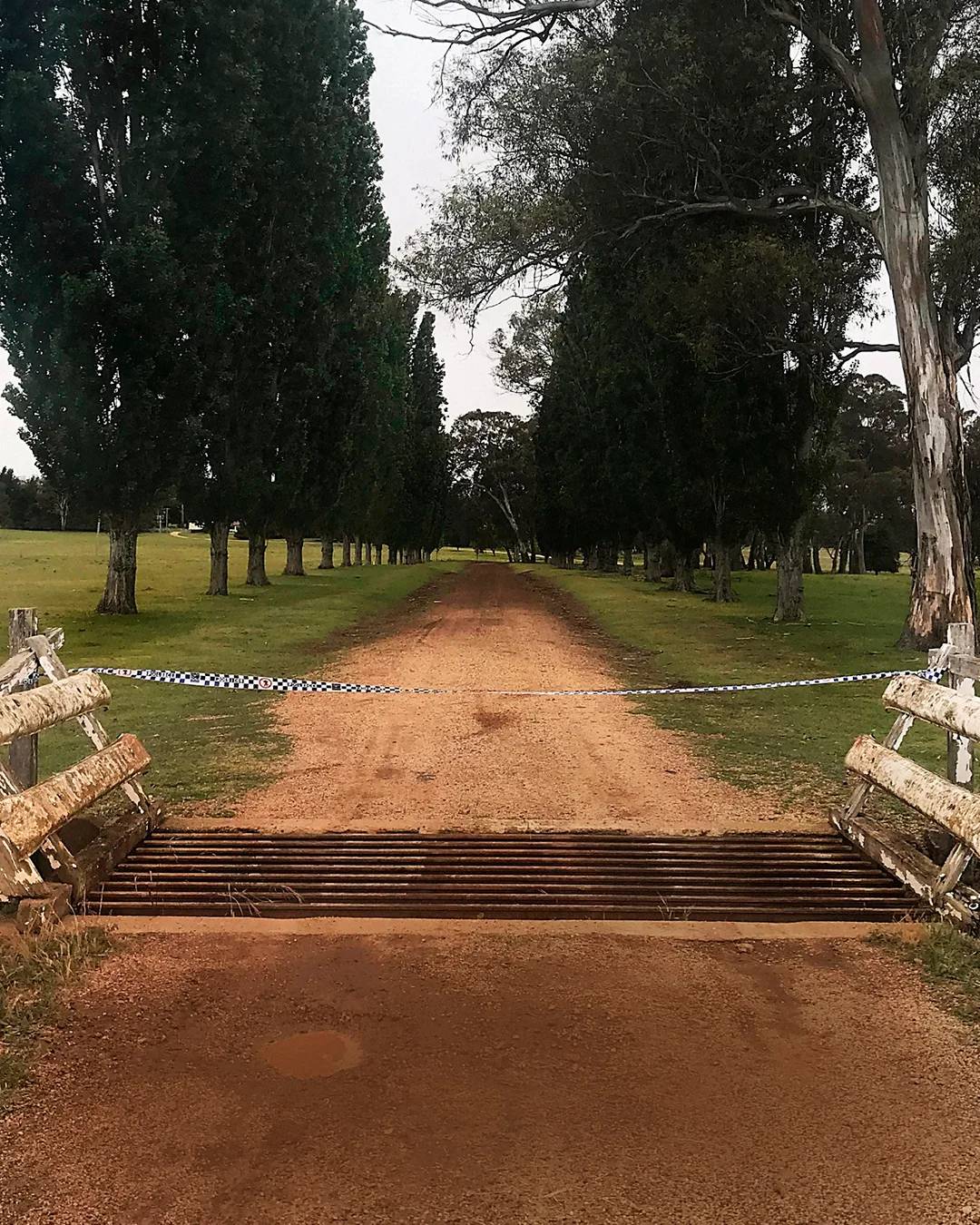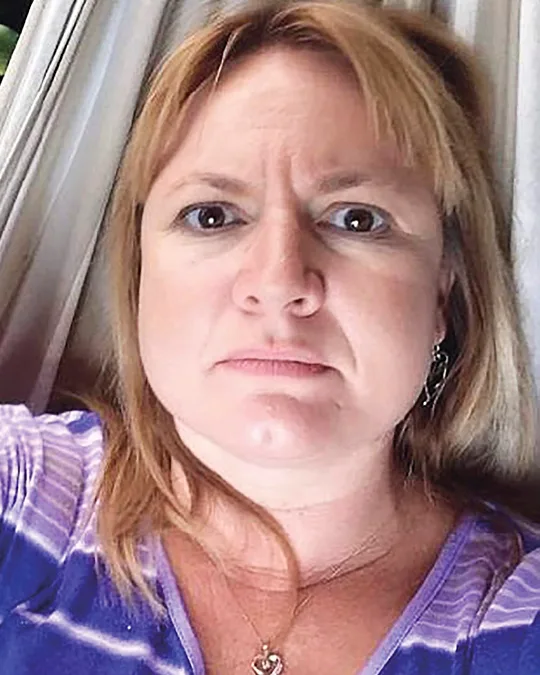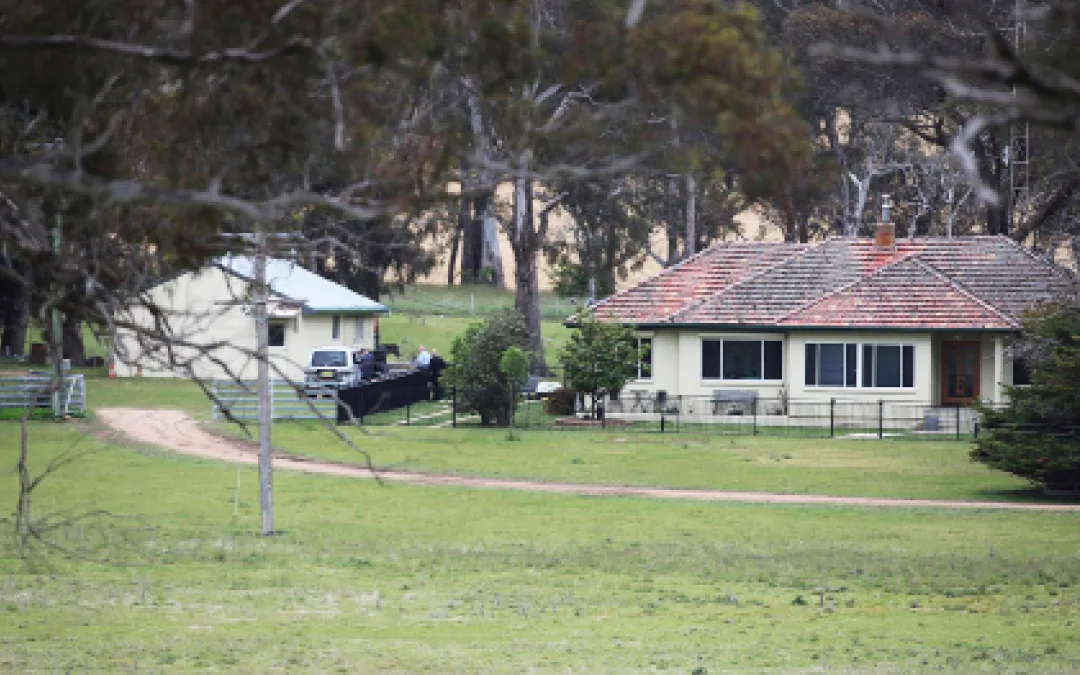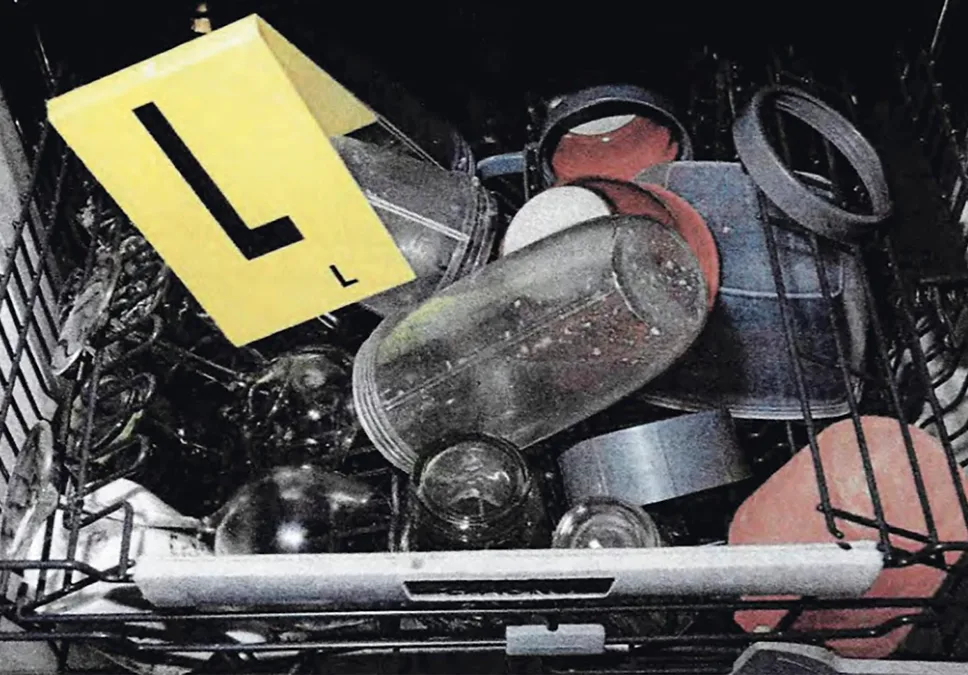Content Warning: This article contains mention of suicide, violence and murder.
The pencil pines that line the winding, dirt driveway mean we can’t see the farmhouse, leaving us blind as to what awaits us at the end. My chest tightens as we edge closer.
As a crime reporter, I’ve travelled to the cool and misty town of Walcha, just east of Tamworth in the NSW Northern Tablelands, to confront a so-called ‘black widow’.
She is being investigated for the murder of her grazier boyfriend, Mathew Dunbar, not long after he made her the sole beneficiary of his multimillion-dollar sheep farm.
While the farmer’s girlfriend claims it was a suicide, most of the town is convinced she played a role in his death and, two months on, is still living free in town.

The entrance to the 1200-acre property where journalist Emma Partridge confronted the ‘black widow.’
(Photo: Emma Partridge)Her past is chequered – well known for targeting her partners in her quest for wealth – and there is a collective sense of unease in the tight-knit community.
Many want to know why she hasn’t been arrested, and why she’s still living on the farmer’s 1200-acre property, Pandora, with her three children.
Not long after photographer Nathan Edwards and I reach the farm gate at the end of the driveway, 42-year-old Natasha Beth Darcy walks towards us.
This is Walcha’s black widow.
Wearing light denim jeans and a tight-fitting pink polo top, she flashes us an ear-to-ear smile.
My heart is beating out of my chest. I begin a bumbling apology about turning up unannounced, and explain we are reporting on the death of her partner, but I’m interrupted mid-speech.
Natasha takes a short phone call before turning her eyes back on us.
“They’ve just closed it all now,” she says, referring to the police investigation. “So, they’re giving me all my computer stuff back, all Mat’s phones and everything. That’s what I found out just then.”
“That must be a relief,” I respond, surprising myself that any words made it out of my mouth.
“Well, I knew it was going to close eventually, ” she says. “I mean, I was there. I know he killed himself.”
I ask her what happened the night Mathew died and, perhaps buoyed by the fact that she thinks Mathew’s death has been ruled a suicide, she talks freely.
“Mat was gentle, sweet, kind,” she says, wiping a tear from her eye, before launching into a well-rehearsed monologue. “He suffered depression his whole life. Tried to kill himself twice,” she says.

Walcha’s black widow – Natasha Beth Darcy.
(Photo: Facebook)She also claims he had fallen into a dark hole of depression following a mysterious calf infection which had left him with a permanent limp.
When I ask if she wants to address the rumours in town, or anything about her criminal history, her sudden frostiness is petrifying.
“Hmm,” she says shaking her head. “No. Nup.” Not knowing what else to say, I force a smile back, knowing I can’t take it any further.
I hastily thank her for her time and start walking backwards to the car, her eyes still fixed on us.
Little does she know, in two days’ time she will be arrested.
In a stranger than fiction twist, I learn the first paramedic on the scene for the death of Mathew was Natasha’s estranged husband, Colin Crossman, a man she was once charged with trying to kill.
In the weeks before Nathan and I approached her in Walcha we had seen the pair together, seemingly still close.
It was hard to comprehend why he had anything to do with her when, eight years earlier, in 2009, she hit him over the head with a hammer in bed.

Natasha and Mathew Dunbar.
(Photo: Facebook)Colin survived the attack, and Natasha later fed him a meal of tacos laced with drugs before torching their family home while he lay sedated in bed.
She’d done this shortly after applying for life insurance which would give her $700,000 in the event of his death.
Despite being charged with Colin’s attempted murder, Natasha ended up pleading guilty to the lesser charge of destroying property by fire but was forced to admit what she’d done.
At age 34, this was her first criminal conviction. Aside from fabricating stories to better herself in the past, this was the first time she’d used violence to achieve wealth.
Curiously, Colin stood by her, the pair maintaining contact after she served nine months in jail.
Friends and investigators close to the case tell me he was desperate to keep his family together, having cared for Natasha’s two children – fathered by other men – since they were young.

Natasha’s estranged husband, Colin, who she was charged with trying to kill.
(Photo: Facebook)She also fell pregnant with a third child shortly after she was charged with attempted murder, claiming Colin was the boy’s father.
Despite getting off lightly for her crimes, Natasha didn’t stop here. Having no job or qualifications – and obsessed with money and chasing a better life – she set her sights on her next victim, a man she thought could care for her financially.
However, when things soured with Walcha local Fred Nicholson, she stole his credit card before going on an almighty shopping spree in the nearby town of Armidale, blowing more than $7500 at Dick Smith, Noni B and groceries at IGA.
After she was charged, Natasha falsely accused Fred of assaulting her in an attempt to blackmail him into changing his police statement.
Fred, a horse breeder who lives in a nearby town, tells me he “dodged a bullet” and believes Natasha had her sights firmly on Mathew Dunbar before their relationship ended.
“I was a mullet and Mathew Dunbar was a marlin,” Fred says, referring to Mathew having much more wealth.
It appeared Natasha targeted vulnerable and lonely men, using her sexuality and children to reel them in.

Fred Nicholson said “he dodged a bullet.”
(Photo: Supplied and used with permission)First Colin, who’d been single for years after the death of his wife in a car accident, then Fred, who was living by himself on a rural property following a divorce. Her final target, Mathew, was open about his desperate search for love and a family of his own.
After meeting Mathew online in late 2014, Natasha showered him with compliments and affection, but within months it was clear she was interested in much more.
“Don’t forget you need to change your will,” she texted Mathew six months after their romance first blossomed.
She persisted, the following month asking him, “Can you promise to do one thing for me this week? Call solicitor for appointment to sort your will.”
Mathew, known by all who knew him as generous in the extreme, eventually capitulated.
“Rang solicitor and organised will change. I love you so much beautiful xoxoxoxoxoxoxoxox,” he texted.
But shortly after this, Natasha was sentenced to 18 months in prison for her previous crimes against Fred.
Mathew lovingly stood by her, co-parenting her children with Colin, until she got out. Once she was out of jail in October 2016, it wasn’t long before she set her mind to murdering Mathew.
Natasha undertook the first of hundreds of murderous internet searches in February 2017, using Google to look up natural causes of death relating to poisonous spiders, mushrooms and “11 toxic plants that look like food”.
She later upped the ante, searching “how to commit murder”, “murder by injection” and “99 undetectable poisons”.
While relentlessly researching methods to kill, Natasha laid a false trail, telling anyone she could that Mathew was depressed and suicidal.
Phone records reveal she Googled dozens of ways to suicide including, “how to commit suicide”, “food processor recipes”, “Valium suicide”, “sedative suicide”, “lethal dose of clonidine”, and “drugs for suicide”.
After months of research, she progressed to a planning phase, approaching the local Walcha vet to purchase a powerful ram sedative, despite having nothing to do with the day-to-day running of the farm.

‘Pandora’ the property Natasha stood to inherit.
(Photo: Supplied and used with permission)The vet was so concerned about Natasha’s unusual request she contacted local police and made a statement, raising a widespread fear in town that Natasha was out to harm Mathew.
After trying several other vets in nearby towns, Natasha eventually got her hands on the animal sedative, acepromazine, before sourcing prescription drugs from a jailbird friend and squirrelling away a “lost” bottle of her son’s ADHD medication.
Again, she turned to her phone, searching, “what would acepromazine do to a human”, “acp suicide” and “acp injection suicide”.
Yet, it wasn’t until a few days before Mathew’s death that her plan truly crystallised, after she came across a website which recommended helium asphyxiation as the best method of suicide.
After consulting her phone to search “suicide helium”, “Spotlight helium” and “gas bottle”, Natasha later ordered a cylinder of helium from a Supagas store in Tamworth, claiming she was hosting an upcoming event and that a man by the name of Mathew Dunbar would pick it up the following day.
On the final day of his life, August 1, 2017, Mathew attended Tamworth hospital for a mysterious calf infection, not knowing Natasha had injected his leg with the ram sedative in what her trial would later hear was a “dry run” before the murder.
While Mathew posted an update on Facebook outlining his ordeal, Natasha watched a YouTube video about the method she would use to kill him later that night.
After arriving home from hospital, Natasha blended a cocktail of drugs – including her son’s medication and acepromazine in a NutriBullet – before giving it to Mathew to drink.
Once sedated in bed, Natasha placed a plastic bag over Mathew’s head before inserting a length of shower hose underneath, secured with elastic around his neck.
She then turned on the helium tank and gassed him.
At 12.36am she used Mathew’s phone to search, “is helium traceable autopsy” before sending a fake suicide note to Colin at 1.14am: “Tell police to come to house. I don’t want Tash or kids to find me.”
About this time she also deleted her phone’s entire internet history.
When she didn’t receive any response, Natasha phoned triple 0 to report Mathew’s apparent suicide, acting out CPR on speaker phone until Colin and a colleague the local paramedics rostered on that night – arrived and pronounced Mathew dead.
Natasha’s phone was her ultimate undoing.
Despite looking up “can police see past web history,” and “if police have iPhone can they see deleted iMessages,” forensic specialists were able to retrieve all her murderous searches.

Emma Partridge’s new book – The Widow of Walcha
(Photo: Supplied and used with permission)Local police were well aware of her track record and they acted swiftly, declaring Pandora a crime scene and collecting key evidence – including a glass in the dishwasher that contained the residue of the drugs Mathew had ingested.
One officer tells me that if Natasha had killed someone in another town where no one knew her, it’s possible she could have got away with murder.
Red flags were also raised when Natasha spun a web of lies in her police interviews, claiming she had no idea she stood to inherit Mathew’s farm despite witnesses, phone messages and recorded calls proving otherwise.
Once police were in possession of a sickening cache of internet searches and phone data, plus evidence of Natasha sourcing the drugs found in Mathew’s system and proof she ordered the helium, they had enough to make their move.
0Two days after my front-page story about the ‘Widow of Walcha’ hit the newsstands, I stood on the edge of the property and watched as police sped down the driveway of Pandora to arrest Natasha in November 2017.
While I thought I knew everything about Natasha and the way she callously murdered Mathew, I had only scratched the surface of what later emerged at her NSW Supreme Court trial almost four years after her arrest.
In three police interviews played to the jury, Natasha painted Mathew as a depressed, lonely, homosexual farmer whom she claims she tried to save.

A glass in the dishwasher was a key piece of evidence in the trial.
(Photo: NSW Supreme Court)It was a character assassination of the man who had done everything to provide for her. Natasha’s twisted aim was to prove he’d taken his own life.
Mathew was depressed in the months leading up to his death, but this was mainly due to his deteriorating relationship with Natasha.
He was also stressed about cash flow, unable to stop Natasha spending money on big ticket items, including a $30,000 horse float.
During the trial a psychiatrist gave evidence that Natasha had emotionally manipulated Mathew, “gaslighting” him with “cruel comments” and goading him to take his own life.
1She once asked him “if the rafters in the shed were high enough for him to hang himself”, which led to him threatening suicide six weeks before his murder.
Following a two-month trial, a jury found Natasha guilty of murder, and in February this year, Justice Julia Lonergan sentenced her to 40 years in jail with a non-parole period of 30 years, meaning she will be in her early 70s by the time she gets out.
People often ask me if something happened to Natasha as a child, or whether there was a traumatic event that could explain her becoming a murderous psychopath.
By all accounts she grew up in a loving family, but one which was strictly religious. Animals were her passion and she was lucky enough to grow up with horses on a small acreage in NSW’s Hawkesbury region.

Natasha was finally sentenced in February of this year to 40 years in jail.
(Photo: Supplied and used with permission)In her teens she had a casual job at McDonalds before working as a vet nurse, but was always known to fabricate wild and elaborate stories, mostly for attention.
Those who know her say it’s hard to pinpoint when, but somewhere along the line, money became her sole focus.
To this day, Natasha continues to protest her innocence, and while she was assessed by two forensic psychiatrists, it was hard for them to come up with a definitive diagnosis.
2One found she had “personality disorder” with a clear tendency to manipulate and lie to partners, while another said she had a “dependent personality structure”.
While there are no clear answers as to where it all went so wrong for Natasha, friends and ex-partners – those still alive to tell their tales – help to paint a picture of a woman who used vulnerable people to get ahead, and the scale of her elaborate plans and lies increased with each new relationship.
The finer details of her previous crimes were chillingly similar to the way in which she would eventually murder Mathew and leave a small town reeling from his loss.
The Widow of Walcha by Emma Partridge, Simon and Schuster, is on sale on May 4.If you or someone you know needs help, call Lifeline 13 11 14.
You can read this story and many others in the May issue of The Australian Women’s Weekly – on sale now.

.jpg?resize=380%2C285)


